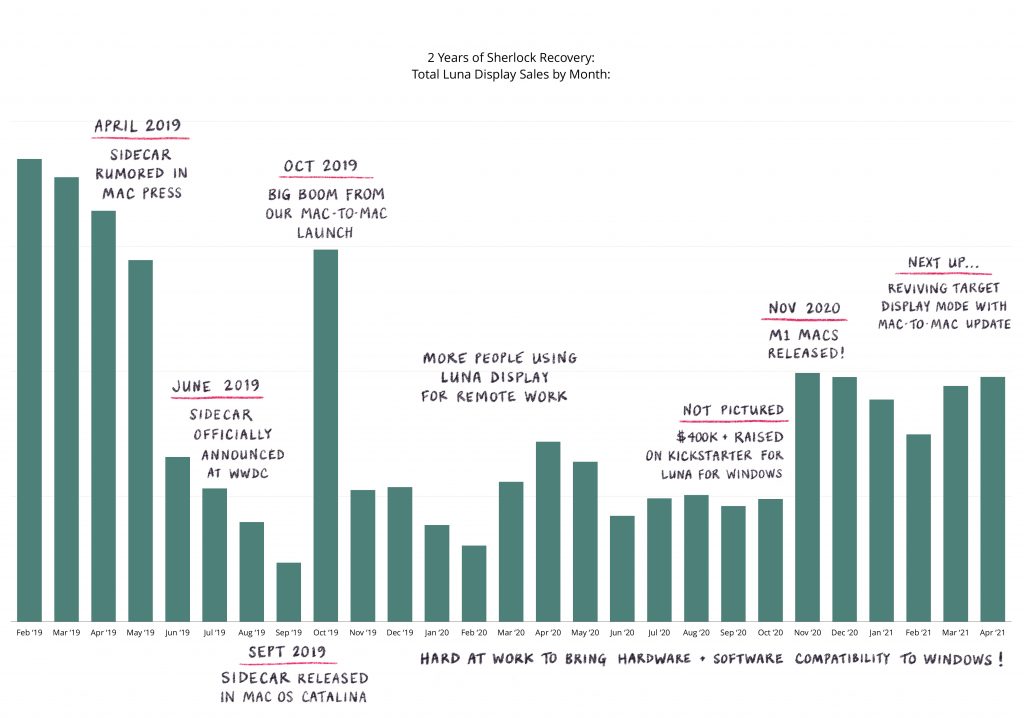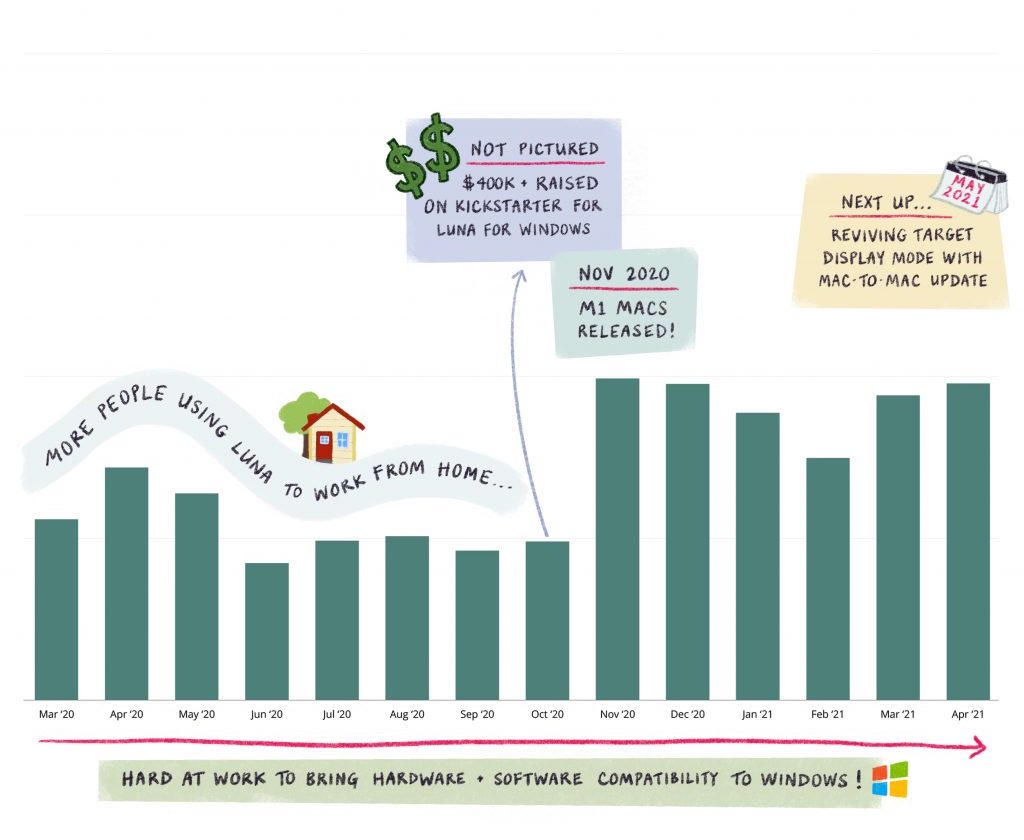This June marks Astropad’s “two-year sherlocking-anniversary.”
Calling it an anniversary is a bit tongue in cheek. It’s less celebratory and more… reflective. 🙃 Getting sherlocked was the crucible we needed to face our vulnerabilities as a business; it hurt, but we’ve openly admitted that it made us both sturdier and more nimble.
If you’re not familiar, “sherlocking” is when Apple copies the product of a third-party developer and offers it as a free feature. It’s why Apple is currently being investigated for antitrust by the U.S. government.
In June 2019, Apple announced Sidecar, a feature in macOS Catalina that directly copied Luna Display. This came after Astropad’s founders were invited out to Apple headquarters multiple times to present on Luna Display, and after Apple purchased thousands of dollars worth of Luna units. As a small, bootstrapped company, it was a huge blow.

What we wish we knew two years ago
We’ve been candid about the emotional toll of getting sherlocked. But until now we’ve never shared the financial toll — mostly because it was still unfolding. But now that we’re two years out, we have a more complete financial story to share.
Rewinding our mindset back to two years ago, there was so much fear as to whether or not we could even survive as a company. As soon as our sales started to fall, we didn’t know where the bottom would be, and if there was a future for our team.
With that in mind, we’re sharing the financial story that we wish we could foresee two years ago. Hopefully it can help other underdogs out there that may find themselves in a similar situation.

Year 1: Financial freefall and uncertainty
October 2018
We officially open Luna Display for Mac for public availability! We didn’t include this on the timeline because Luna’s initial release, and the abundant holiday sales that followed, were outlier data. But our sales are off to a hot start, and they stabilize early in 2019.
February 2019
After the overwhelming success of Luna’s initial launch, sales reach an equilibrium around January / February. We ramp up advertising spend and hire new team members to keep up with the Luna demand. Full steam ahead!
April 2019
The first rumors emerge about a potential second display feature in macOS. We immediately see Luna sales take a dip in April and May.
June 2019
After two months of rumors, Apple officially announces Sidecar at WWDC. Luna sales take an initial nosedive and continue to plummet for the next three months. Internally, we stop all hiring and advertising in an effort to control costs.
Meanwhile, we determine the only path forward is to bring our products to the Windows market.
September 2019
Apple releases macOS Catalina with the Sidecar feature. Sales bottom out at 13% of their previously stable rate in February.
October 2019
We release Mac-to-Mac Mode for Luna Display — a new feature that allows you to use a second Mac as a display for your primary Mac. The update is met with enthusiasm, momentarily driving sales back to their pre-sherlock levels.
November 2019 – February 2020
Following the hype around the Mac-to-Mac Mode launch, our sales settle at a new baseline. We see a small spike in holiday sales, which even out in early 2020. The team is deep in the trenches to bring Luna cross-platform.

Year 2: Working hard to bring Luna cross-platform
March 2020
The COVID-19 pandemic hits the United States, and suddenly more people are working remotely. We are fortunate to see Luna sales benefit from an increased need for remote productivity tools.
October 2020
We launch a successful Kickstarter campaign for Luna Display for Windows! The campaign allows us to validate the Windows market and raise funds for the initial manufacturing round. We haven’t delivered those Kickstarter units yet so we didn’t include the money raised on the financial timeline.
November 2020
Apple announces its new line of Macs featuring the M1 chip. We add M1 support to our product lines and see immediate performance enhancements.
April 2021
Through a combination of Mac-to-Mac Mode, more people work remotely, and the new M1 Macs, Luna sales rebound to about 50% of their “pre-sherlock” rate. Looking ahead, we expect the launch of Luna Display for Windows to close that gap.
A big picture view: The forces that changed our trajectory
Throughout this timeline, there were a few pivotal moments that changed our trajectory for the better. Some were powerful global forces, such as the COVID-19 pandemic. Others were brought on by Apple itself, such as the introduction of the new M1 chips. But those external forces were totally unexpected, and while we’re fortunate for the boost they brought to Luna sales, those factors were out of our control.
If you’re in the position of getting sherlocked, the only real strategy is to look at the internal forces in your control. What levers can you pull? How will you choose to allocate engineering resources? That’s where the real nimbleness comes in.
The levers we pulled that worked
Adding Mac-to-Mac Mode was pivotal. For our existing customers, it was a free feature that added significant value to the product. It also sent a message to our customers that despite the setbacks, we were still committed to improving our products. In other words, we were doubling down.
Not only did the new feature benefit existing customers, but it also brought in a new user group by filling a gap that Apple’s Sidecar did not. We positioned Mac-to-Mac Mode as a third-party workaround for Target Display Mode, a beloved macOS feature that went unsupported by Apple in 2014. You can call that a “reverse sherlock.”
Building beyond the Apple ecosystem
In the first few years of Astropad’s existence, we were too dependent on the Apple ecosystem, and we paid the price. To dig our way out, in the summer of 2019 we reoriented the entire Engineering Team to begin writing cross-platform code in Rust. They faced a steep learning curve, and the journey to translate every line of code has been difficult.
Nevertheless, we saw some great validation in September 2020 with our successful Kickstarter campaign for Luna Display for Windows (not shown on the graph). Still, we have yet to fully actualize the financial benefits of going cross-platform.
We made a long-term bet that breaking outside of the Apple ecosystem could restore our finances to pre-sherlock levels, and then some. The story’s still unfolding, but two years in, things are looking up.




